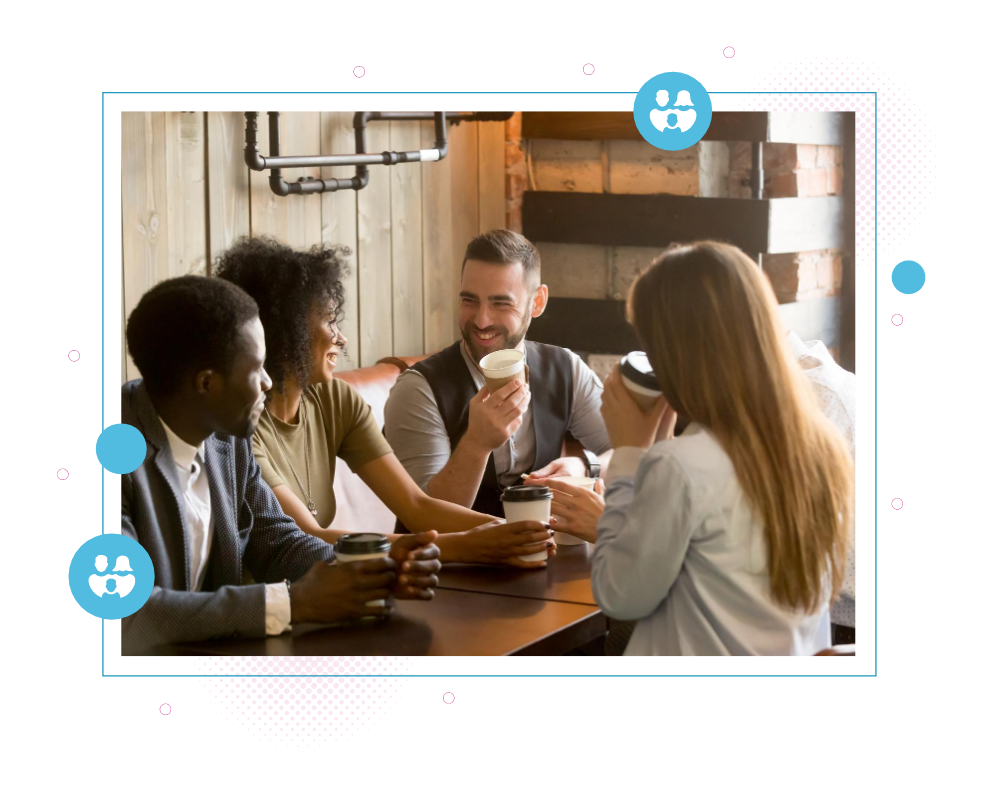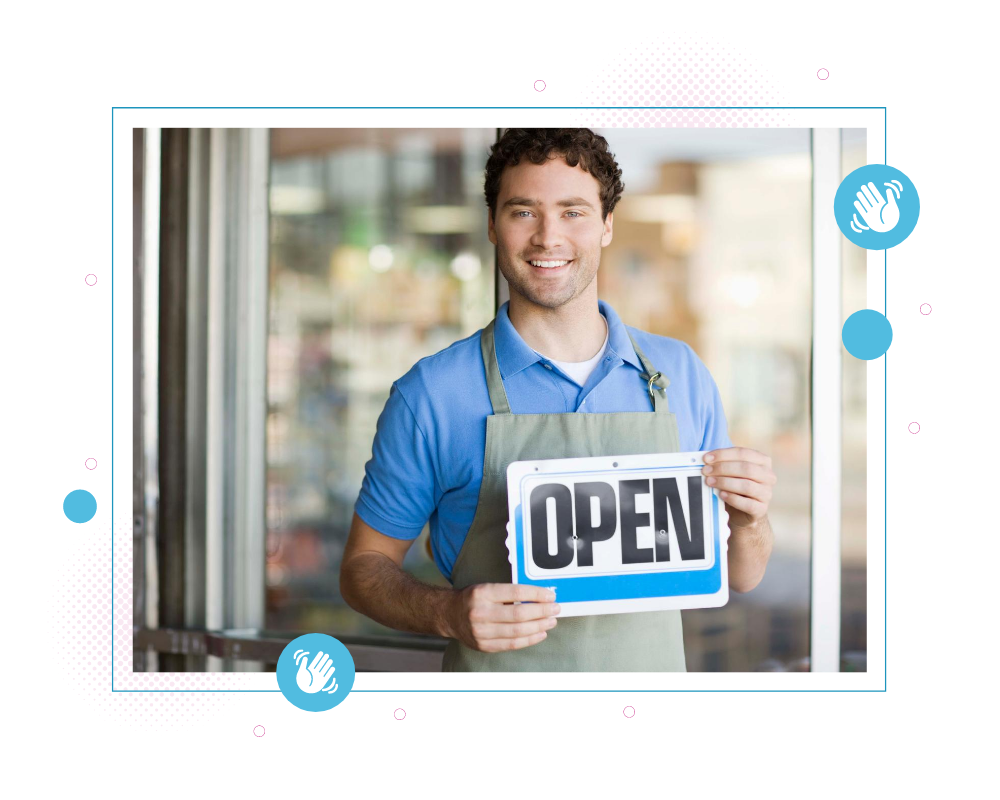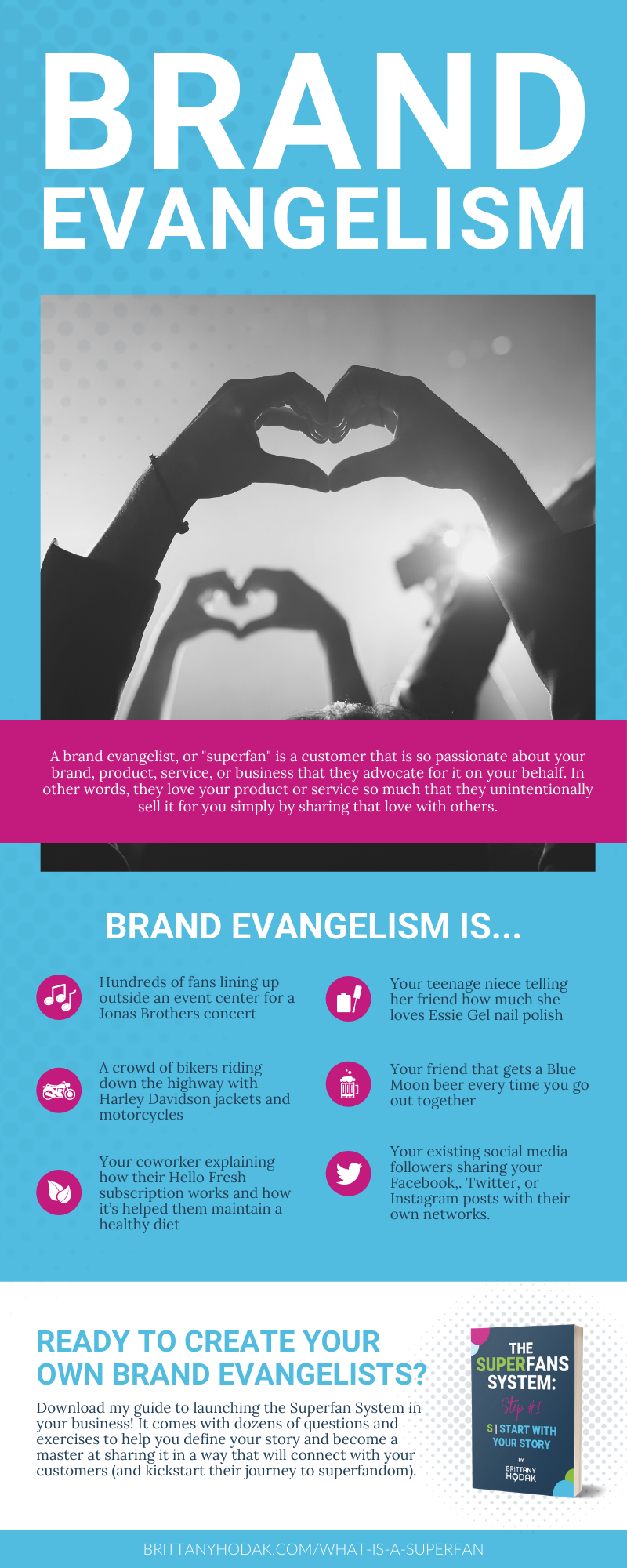As any experienced businessperson knows, customers come from many channels. Some find your brand through a social media video, others through a live event, and still others through paid advertising. In this blog, we’re going to focus on another channel that creates new customers: brand evangelists. We’re also going to answer the question, “What is a brand evangelist?”
A brand evangelist is a customer who is so passionate about your brand, product, service, or business that they advocate on your behalf. In other words, brand evangelists love you so much that they create more customers by sharing your story.
Another term for “brand evangelist” – and one that has been growing in popularity – is “superfan.” Since it was first used in 1918, Merriam-Webster has defined “superfan” as “an extremely enthusiastic or dedicated fan,” and while it’s often used to describe sports, music, or pop-culture fans, it can apply to any vertical. This includes product or service-oriented businesses, from your local grocer to your favorite brand of shoes.
Whether you prefer the term “superfan” or “brand evangelist,” these customers exist for every category of product and service, and they come in all ages and from every background and income bracket. Because of this, their impact on your business can be monumental and the importance of creating superfans cannot be understated.
So what is a brand evangelist and how can you create them? Let’s talk about that! 🤔
What does brand evangelism look like?

A brand evangelist or superfan can come from any background in any industry. This makes answering the question, “What is a brand evangelist, in a literal sense?” a bit harder, as there isn’t a set definition for what “brand evangelism” looks like. In fact, it includes a wide range of activities, and one or another may be more applicable, depending on your brand. Below are a few of my favorite examples:
Brand evangelism is…
- Hundreds of fans lining up outside an event center for a Jonas Brothers concert.
- Your coworker explaining how their Hello Fresh subscription works and its role in helping them maintain a healthy diet.
- Your teenage niece telling her friend how much she loves Essie Gel nail polish.
- A crowd of bikers riding down the highway with Harley Davidson jackets and motorcycles.
- Your friend that gets a Blue Moon beer every time you go out together.
- Your existing social media followers sharing your Twitter, Facebook, and Instagram posts with their own social networks.
Essentially, a brand evangelist goes out of their way to share their affinity for a given company, product or service. The other details – where they are, what they’re promoting, and who they’re addressing – can vary immensely. However, it’s important to note that unlike influencers or celebrity endorsers, superfans don’t receive payment for their promotions. They share their experiences and preferences simply because they’re so excited about them!
Why are brand evangelists/superfans important?
That brings me to the next component of superfandom: answering the question, “What is a brand evangelist and why are they important?” In the simplest terms, answering this question means looking at the numbers. Whether we’re talking energy expended, time used, or money earned, the ROI from creating superfans can be massive.
Potential customers trust recommendations from friends or family.
First, in terms of energy and time, brand evangelists are incredibly effective salespeople. When you sell on your own behalf, you have to introduce yourself and your offering(s) and establish a connection with your “lead.” However, even after introducing yourself and establishing some level of trust, you have to not only explain the benefits of your product or service. You also have to explain the advantages of choosing your brand over your competitors. Although this may seem straightforward, this can be difficult when a customer knows they’re being “sold to,” as they may consider your recommendations to be based on self-interest rather than consideration for their needs.
That’s where brand evangelists or superfans come in. Unlike salespeople, brand evangelists have no self-serving reason to promote a brand. They’re not receiving a commission, and they’re not paid to advertise – They’re just passionate! Consequently, when a superfan shares the advantages of your brand, potential customers are more likely to seriously consider their recommendations. In fact, according to Nielsen, 83% of people trust recommendations from their friends and family members while only 18% say they trust salespeople. That gap means that, compared to a superfan, you have to work a lot harder for a lot longer to create a customer.
Brand evangelists are the least expensive form of new business.

Besides effort and time, brand evangelists are also important in terms of revenue. Because potential customers are so much more trusting of friends and family members, a brand evangelist in either of those categories dramatically increases your chances of turning that first person into a customer. Whether an evangelist shares their preferences in person, through text, or on social media, they’re not simply acting as a reliable source of information for their audience. They’re also the most-trusted method of earned, paid, or controlled advertising that you can hope for.
Admittedly, most people may not consider themselves influencers, and many of us may not even realize we’re acting as a brand evangelist in our day to day lives. That said, whether we’re consciously supporting a brand or not, we’re all remarkably influential. In the context of social media, for example, 72% of Americans use social media regularly to connect with hundreds (and sometimes thousands) of trusted peers. In those interactions, that feeling of connection matters, and, as a result, everyone’s words and recommendations hold weight. Don’t believe me? Just ask some of the almost 200 million people who visit Yelp each month looking for reviews!
In short, brand evangelists don’t just create new customers with less time and effort than your own salespeople. They also do it at a fraction of the cost, sometimes sharing your brand with thousands of followers or Internet visitors at once and never costing you a dime. That means less time your team members have to spend on the phones and more time they can be providing exceptional customer service, creating more superfans in the long run. It’s a win for you, your team, and your customers!
How do businesses create brand evangelists/superfans?
At this point, we’ve covered all of the basics of “What is a brand evangelist?” Now, let’s talk about how to create them. In the following four steps, I’m going to introduce you to my Superfan W.A.V.E. methodology. It’s an easy-to-remember mantra that will help create experiences and interactions your customers won’t be able to forget and, more importantly, won’t keep to themselves. 👍
Make potential customers feel welcome.

First and foremost, to create a superfan, you have to make potential customers feel welcome. Although this may sound like a given, I’m sure you can think of a time when you were made to feel unwelcome in a place of business. I know I can. On more than one occasion, I’ve felt unwelcome at a business where I planned to make a purchase, although this was likely unintentional on the salesperson’s or business owner’s part. Whether it was a rude look from an employee, a strange glance from a restaurant hostess, or a blog post or meme on a business’s website making a “joke,” there have been several occasions where I chose a different business simply because I didn’t feel like the first one truly wanted me there.
In the same way, making people feel welcome in your own business is the foundation upon which all other stages of the Superfan W.A.V.E. build. One sometimes scary reality for business owners is that everyone at your company will, at some point, almost certainly be responsible for someone’s first impression of your brand. It might be at work, but it’s equally likely that person—who is in many ways representing your business from the moment they wake up to the moment they go to bed, including their every social media post—will help inform someone’s opinion of your company while in a social setting. This is why it’s critical that every person in a company is taught why it’s so important to create an environment and culture where everyone feels welcomed.
Show existing customers that you appreciate them.

The second step to creating a superfan is showing customers that you appreciate them. From their first interaction with your business to the day of their last purchase, each customer should be confident that you not only appreciate their purchase. You also appreciate their consideration in the first place. After all, they chose you over all of the other companies in your arena. That should mean a great deal!
In short, each customer should know that you value them and their business. If they feel like their patronage doesn’t matter — as if they’re just another sale — there’s a strong chance they’ll start looking for a partner who treats them better. Essentially, your business is in a relationship with each customer, and just like you wouldn’t recommend that your friend stay in a bad relationship, customers aren’t going to stick around if you don’t show them you care about them in return.
A great rule of thumb to follow is the Platinum Rule, from Doctors Tony Alessandra and Michael J. O’Connor in their 1998 book of the same name. This rule takes the classic Golden Rule, “Treat others the way you want to be treated,” one step further. To put it briefly, the Platinum Rule argues that every person is an individual with different wants and needs. Consequently, not everyone wants to be treated the same way so, rather than follow the Golden Rule, it’s better to “Treat others the way they want to be treated.”
To do this, don’t be afraid to ask potential and existing customers what’s important to them and pay close attention to their answers. Ask follow-up questions, and, most importantly, overuse “thank you” (but always sincerely!). Remember, you’re there to show them you appreciate their support, and part of that means appreciating their feedback.
Validate potential and existing customer questions and concerns.

Third, to create a superfan, you have to validate the feelings, questions, and concerns of potential and existing customers. After showing customers you want them around and you care about them, you then have to get on their level. Show them that you’re there to be of service and you don’t think you’re better or smarter than they are, simply because you have the answers to their questions.
The best explanation of this step comes from Oprah Winfrey. In 2011, on her final daytime-talk-show broadcast, Oprah shared the most important lessons she had learned about people over the years, including the following insights around validation.
“I’ve talked to nearly thirty thousand people on this show, and all thirty thousand had one thing in common: They all wanted validation…They want to know: ‘Do you see me? Do you hear me? Does what I say mean anything to you?’ … It has worked for this platform, and I guarantee you it will work for yours. Try it with your children, your husband, your wife, your boss, your friends. Validate them. ‘I see you. I hear you. And what you say matters to me.’”
Summarily, with any product or service, when we feel validated, we feel like we matter. We begin to feel like we’re part of something bigger than ourselves. This forms the beginning stages of community, which is a precursor to engagement—the ultimate level in which superfandom can truly begin to take form.
Ensure your customers feel engaged with your brand.

Finally, to create superfans, ensure that your customers are engaged with your brand. Forrester defines customer engagement as “creating deep connections with customers that drive purchase decisions, interaction, and participation, over time.” I like to think of it in terms of a romantic engagement: When two people are engaged, they aren’t looking for anyone else. They’ve made a commitment to be together. When a customer is engaged, it’s a similar dynamic: They love your company (or product or service) and aren’t going to seek out competitors, because you’re “the one.”
So how do you make your customers feel engaged? For many business owners, the answer is as simple as having regular dialogue with customers. Ideally, both yourself and the members of your team should be available to chat wherever the customer is whether that’s in person, over the phone, via email, through social networking sites, or on a virtual conferencing platform. Whatever your mode of communication, engaging with customers goes beyond troubleshooting or traditional “customer service.” Instead, it’s about creating and sharing helpful content and information your customers will enjoy consuming and sharing with others in their network. See how we’ve come full circle?
Ultimately, answering the question “What is a brand evangelist?” is really about looking at your existing customers and thinking about how you can make them happier. The idea of brand evangelists or superfans can be incredibly impactful, especially when you consistently provide service so out-of-this-world that customers can’t help but to tell their friends.
For more information about creating brand evangelists, check out my complete explanation of superfandom or download my free guide, The Superfans System: Step #1.

